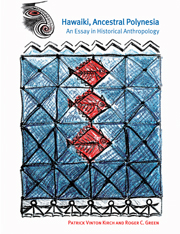Book contents
- Frontmatter
- Contents
- List of figures
- List of tables
- Preface
- List of language abbreviations
- Prologue: on historical anthropology
- Part I The phylogenetic model: theory and method
- Part II Rediscovering Hawaiki
- Introductory remarks
- 4 The Ancestral Polynesian world
- 5 Subsistence
- 6 Food preparation and cuisine
- 7 Material culture
- 8 Social and political organization
- 9 Gods, ancestors, seasons and rituals
- Epilogue: on history, phylogeny, and evolution
- Notes
- Glossary of terms
- References
- Subject Index
- Index of Proto Polynesian Reconstructions
6 - Food preparation and cuisine
Published online by Cambridge University Press: 06 January 2010
- Frontmatter
- Contents
- List of figures
- List of tables
- Preface
- List of language abbreviations
- Prologue: on historical anthropology
- Part I The phylogenetic model: theory and method
- Part II Rediscovering Hawaiki
- Introductory remarks
- 4 The Ancestral Polynesian world
- 5 Subsistence
- 6 Food preparation and cuisine
- 7 Material culture
- 8 Social and political organization
- 9 Gods, ancestors, seasons and rituals
- Epilogue: on history, phylogeny, and evolution
- Notes
- Glossary of terms
- References
- Subject Index
- Index of Proto Polynesian Reconstructions
Summary
There is a considerable body of knowledge connected with the art of cooking in Tikopia … a considerable vocabulary of words to describe the state of foods, as cooked and raw, thick and thin, hard and soft.
firth 1936:108The procurement of raw food initiates a chain of activity culminating in a quintessentially human activity: the meal or – at times – the feast. As anthropologists have long known, the transformation of the “raw” into the “cooked,” occurs in culturally specific ways. Cooked food is the essence of culture, partitioned into semiotically marked categories rich with social meaning. Archaeologists usually take their reconstructions of prehistoric foodways no farther than the analysis of diet, augmented at times by studies of butchering patterns and more rarely of cooking facilities, falling far short of a true “archaeogastronomy.” Yet when archaeological evidence can be augmented and extended through triangulation within a phylogenetic model, it is possible to go further. How much further we will demonstrate by sketching a broad reconstruction of Ancestral Polynesian concepts of food and taste, of cooking techniques, recipes, and storage methods. Again, we must weave back-and-forth among independent lines of evidence: from archaeology, comparative ethnography, and historical linguistics.
The comparative ethnography of food is a neglected topic. The classic museum ethnographies of Polynesia cover the material culture of food preparation, but give short shrift to food preparation methods and recipes; a richly nuanced exception is Hiroa's (1930) treatment of Samoan cooking.
- Type
- Chapter
- Information
- Hawaiki, Ancestral PolynesiaAn Essay in Historical Anthropology, pp. 143 - 162Publisher: Cambridge University PressPrint publication year: 2001



